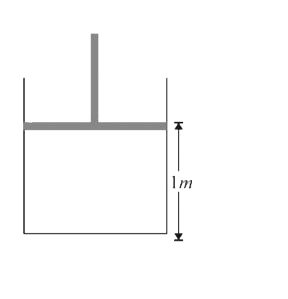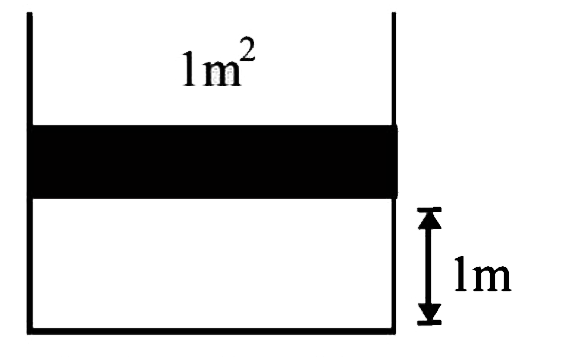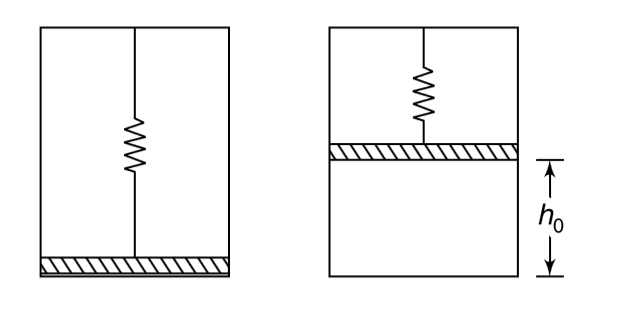The piston cylinder arrangement shown contains a diatomic gas at temperature 300 K The cross sectinal area of the cylinder is 1m2. Initially the height of the piston above th base of the cyclinder is 1 m. The temperature is now raised to 400 K at constant pressure. There is no heat loss in the process..

Find the new height (in m) of the piston above the base of the cylinder.
The correct Answer is:4/3
At constant pressure, V∝T
or V2V1=T2T1 or Ah2Ah1=T2T1 ∴ h2=h1(T2T1)=(1.0)(400300)m=43M
As there is no heat loss, process is adiabatic.
Similar Questions
The piston cylinder arrangement shon contains a diatomic gas at temperature 300 K The crooss sectinal area of the cylinder is 1m2. Initially the height of the piston above th base of the cyclinder is 1 m. The temperature is now raised to 400 K at constatn pressure. Find tge bew jgeauggt if tge oustib avive tge vase if tge cylinder.If the psiton is now brouyght back to its original height without any heat losss, find the new equilibrium temperaturef of the gas. You can leave the answer in fraction.
 View Solution
View SolutionA cylinder fitted with a piston contains an ideal monoatomic gas at a temperature of 400K. The piston is held fixed while heat ΔQ is given to the gas, it is found the temperature of the gas has increased by 20K. In an isobaric process the same ΔQ heat is supplied slowely to it. Find the change in temperature in the second process?
View Solution
Knowledge Check
- Question 1 - Select One
Two cylinders A and B fitted with pistons contain equal amounts of an ideal diatomic gas at 300 K. The piston of A is free to move, while that of B is held fixed. The same amount of heat is given to the gas ineach cylinder. If the rise in temperature of the gas in A to 30 K, then the rise in temperature of the gas in B is
A30 KB18 KC50 KD42 K - Question 2 - Select One
Two cylinders A and B fitted with pistons contain equal amounts of an ideal diatomic gas at 300K. The piston of A is free to move, while that B is held fixed. The same amount of heat is given to the gas in each cylinder. If the rise in temperature of the gas in A is 30K, then the rise in temperature of the gas in B is
A30KB18KC50KD42K
A cylinder fitted with a spring loaded piston, shown in the figure, contains 0.01(m)3 gas at a pressure of 105Pa. The cross-sectional area of the piston is 0.05m2. Initially, the spring does not touch the piston but atmospheric pressure of 105Pa acts on the piston. The gas is slowly heated till the volume is increased to three times the original value. If the forcé constant of the spring is 25kNm, calculate the work done (in kJ ) by the gas.
'(##CEN_KSR_PHY_JEE_C15_E01_031_Q19##)'View SolutionA diatomic gas is enclosed in a vessel fitted with massless movable piston. Area of cross section of vessel is 1m2. Initial height of the piston is 1m (see the figure). The initial temperature of the gas is 300K. The temperature of the gas is increased to 400K, keeping pressure constant, calculate the new height of the piston. The piston is brought to its initial position with no heat exchange. Calculate the final temperature of the gas. You can leave answer in fraction.
 View Solution
View SolutionA freely sliding massive piston is supported by a spring inside a vertical cylinder as shown. When all air is pumped out of the container, the piston remains in equilibrium with only a tiny gap between the piston and the bottom surface of the cylinder. An ideal gas at temperature T0 is slowly injected under the piston so that it rises to height h0 (see figure). Calculate the height of the piston from the bottom of the container if the temperature of the gas is slowly raised to 4T0.
 View Solution
View SolutionThe pressure of a gas contained in a cylinder with a movable piston is 300 Pa. The area of the piston is 0.5m2. Calculate the force that is exerted on the piston.
View SolutionOne mole of a perfect gas in a cylinder fitted with a piston has a pressure P, volume V and temperature T. if the temperature is increased by 1K keeping pressure constant, the increase in volume is
View SolutionTwo cylinders of equal size are filled with equal amount of ideal diatomic gas at room temperature. Both the cylinders are fitted with pistons. In cylinder A the piston is free to move, while in cylinder B the piston is fixed. When same amount of heat is added to both the cylinders, the temperature of the gas in cylinder A raises by 20 K. What will be the rise in temperature of the gas in cylinder B?
View Solution

